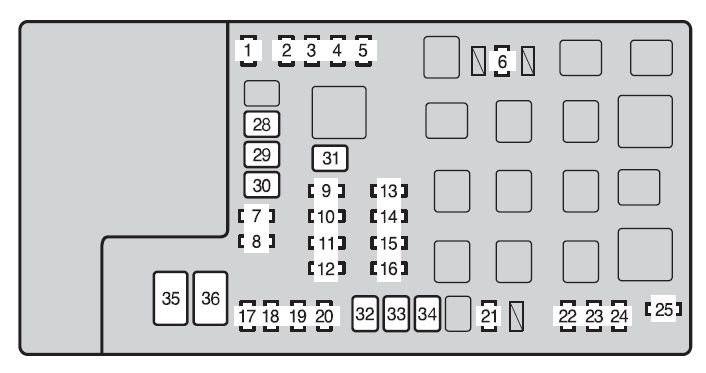The OBD2 port in your 2003 Toyota Tacoma is essential for diagnostics, emissions testing, and accessing your vehicle’s computer system. If you’re experiencing issues connecting a scan tool or failing a smog check, a non-functional OBD2 port could be the culprit. This guide will walk you through troubleshooting steps to diagnose and potentially fix a faulty OBD2 port on your 2003 Toyota Tacoma.
Troubleshooting Steps for a Non-Functional OBD2 Port
If your OBD2 scanner isn’t connecting to your 2003 Toyota Tacoma, follow these steps to pinpoint the issue:
1. Verify Your Scan Tool and Cable
The first step is to rule out any problems with your scan tool itself. A faulty scanner or cable can prevent a successful connection, even if your Tacoma’s OBD2 port is working correctly.
- Test with a Different Scanner: If possible, try using a different OBD2 scan tool. Borrow one from a friend, auto parts store, or a mechanic shop. If another scanner connects, the problem likely lies with your original scan tool.
- Inspect Your Cable: Check the OBD2 cable for any signs of damage, such as frayed wires, bent pins, or loose connectors. If you suspect a cable issue, try using a different cable with your scan tool.
2. Check the OBD Fuse
The OBD2 port is powered by a fuse, typically located in the engine bay or under the dashboard fuse box. A blown fuse is a common cause of OBD2 port failure.
- Locate the OBD Fuse: Consult your 2003 Toyota Tacoma owner’s manual to identify the exact location of the fuse for the diagnostic port or OBD system. It’s often labeled as “OBD,” “Diagnostic,” or “DLC” (Data Link Connector). In many Toyota models of this era, fuses are located in the engine bay fuse box on the driver’s side.
- Inspect the Fuse: Once located, carefully remove the fuse and visually inspect it. Look for a broken filament inside the fuse.
- Test or Replace the Fuse: Use a fuse tester to confirm if the fuse is blown. If you don’t have a tester, replace the fuse with a new one of the same amperage rating. Important: Never use a fuse with a higher amperage rating, as this can damage your vehicle’s electrical system.
 Toyota Tacoma Engine Bay Fuse Box
Toyota Tacoma Engine Bay Fuse Box
3. Examine Wiring and Connections
Faulty wiring or loose connections between the OBD2 port, fuse box, and ECU (Engine Control Unit) can disrupt the communication signal.
- Visual Inspection: Carefully inspect the wiring harness leading to the OBD2 port. Look for any signs of damage, such as cuts, abrasions, or corrosion.
- Check Connectors: Ensure the OBD2 port connector is securely plugged in. Check for any loose or corroded pins within the connector itself.
- Trace Wiring (Advanced): If you are comfortable with basic automotive electrical work, you can use a multimeter to check for continuity and voltage along the wiring between the fuse box, OBD2 port, and ECU. However, if you are not experienced with this, it is best to consult a professional mechanic.
4. Try a Powered OBD2 Scanner
Some OBD2 scanners are powered by the vehicle’s battery through the OBD2 port itself. If there’s a power issue with your Tacoma’s OBD2 port, these scanners might fail to connect. A powered OBD2 scanner, which has its own internal battery or external power source, can bypass this issue.
- Powered Scanner Operation: A powered scanner doesn’t rely on the vehicle’s OBD2 port for power, ensuring it can function even if there’s a problem with the power supply to the port.
- Test with a Powered Scanner: Try using a powered OBD2 scanner to see if it connects to your 2003 Toyota Tacoma. If a powered scanner works, but an unpowered one doesn’t, it strongly suggests a power supply issue with your OBD2 port.
5. Consider Potential ECU Issues (Less Likely)
While less common, a faulty ECU could potentially cause OBD2 communication problems. However, ECU issues are typically accompanied by other noticeable symptoms and are usually diagnosed after ruling out other possibilities.
- Other Symptoms: If you suspect an ECU issue, consider if you are experiencing other problems like engine performance issues, warning lights, or transmission problems.
- Professional Diagnosis: Diagnosing ECU problems often requires specialized equipment and expertise. If you’ve exhausted other troubleshooting steps and still have OBD2 port issues, it’s recommended to consult a qualified mechanic for further diagnosis, which might include ECU testing.
Conclusion
Diagnosing a faulty OBD2 port on your 2003 Toyota Tacoma involves systematic troubleshooting. Start by checking the simplest and most common causes, such as the scan tool, fuse, and wiring. Often, using a powered OBD2 scanner can bypass power supply issues to the port and allow you to access your vehicle’s diagnostic information. If you’ve followed these steps and are still unable to connect to your OBD2 port, seeking professional help from a qualified mechanic is advisable for more in-depth diagnostics and repairs.